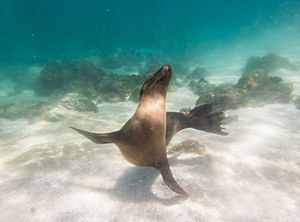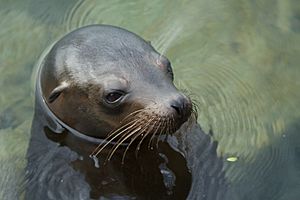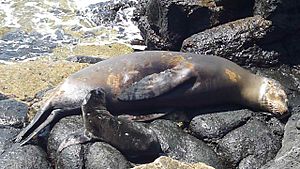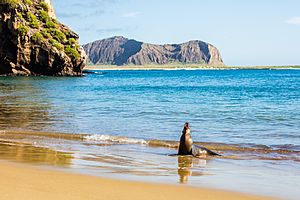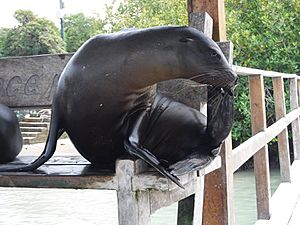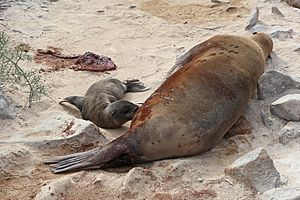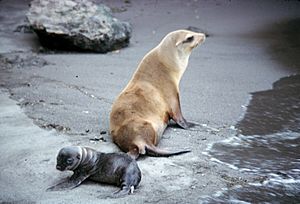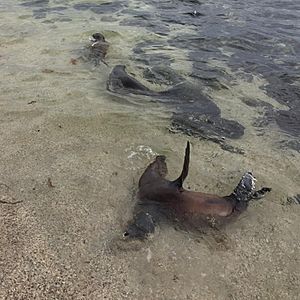Galápagos sea lion facts for kids
Quick facts for kids Galápagos sea lion |
|
|---|---|
 |
|
| Female | |
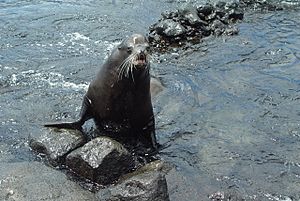 |
|
| Male | |
| Conservation status | |
| Scientific classification | |
| Genus: |
Zalophus
|
| Species: |
wollebaeki
|
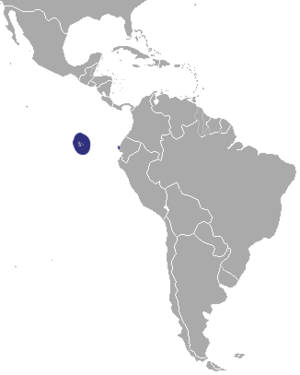 |
|
| Galápagos sea lion range | |
The Galápagos sea lion (Zalophus wollebaeki) is a special type of sea lion. They live and have their babies mostly on the Galápagos Islands. You can also find smaller groups on Isla de la Plata in Ecuador. These sea lions are quite friendly and social. You'll often see them relaxing in the sun on sandy beaches or rocky spots. They also love to glide through the ocean waves. They are actually the smallest type of sea lion!
Contents
What Are They Called?
This amazing animal was first described by a person named E. Sivertsen in 1953. For a long time, many thought it was just a type of California sea lion. They called it Z. c. wollebaeki. But new science, looking at their genes, shows that the Galápagos sea lion is its own unique species. It belongs to the animal family called Otariidae and the group Zalophus.
What Do They Look Like?
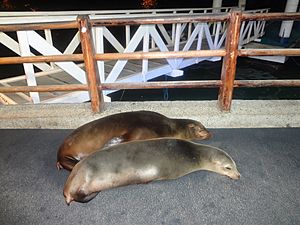
Galápagos sea lions are a bit smaller than their relatives, the California sea lions. They can be from about 1.5 to 2.5 meters (5 to 8 feet) long. They weigh between 50 and 400 kilograms (110 to 880 pounds). Males are usually bigger than females. Adult males also have thicker necks, chests, and shoulders. Females have longer, thinner necks and a thicker body.
When a male sea lion grows up, a small bump appears on his forehead. This is called a sagittal crest. It gets bigger when he becomes an adult. Females and young sea lions don't have this bump. Their heads are mostly flat. Galápagos sea lions have a slightly smaller head bump and a shorter nose area compared to California sea lions.
Both male and female sea lions have a pointy nose with whiskers. They also have a long, narrow snout. Young pups look a bit like dogs! A cool thing about sea lions is their outside ears, called pinnae. These ears help tell them apart from seals. Their front flippers have short fur near the wrist. The rest of the flippers are covered in black, tough skin. The first "finger" on their flipper is the biggest, making it look swept back. Each "finger" has a tiny claw, but you can barely see it.
Even though they might seem clumsy on land, sea lions are super fast and graceful in the water. Their bodies are shaped to glide through water easily. Their flipper-like feet help them push through waves and around sharp rocks. They can also move their flippers separately, which helps them change direction quickly.
When they are wet, sea lions look dark brown. But when they dry off, their color changes a lot. Females are usually lighter brown than males. Pups are born with long, brownish-black fur. This fur slowly turns brown in their first five months. Then, they shed this fur and get their adult coat. Sea lions become adults around 4 to 5 years old. They can live for about 15 to 24 years.
Where Do They Live?
You can find Galápagos sea lions on all the islands in the Galápagos group. Less than a quarter of them live on San Cristobal Island. They have also made homes on Isla de la Plata, which is near the coast of mainland Ecuador. You might even spot them along the Ecuadorian coast, going north to Isla Gorgona in Colombia. There have also been sightings on Isla del Coco, which is about 500 kilometers (310 miles) southwest of Costa Rica. The sea lions on Isla del Coco are thought to be just visiting.
What Do They Eat?
Galápagos sea lions mostly eat sardines. Sometimes, they travel 10 to 15 kilometers (6 to 9 miles) away from the coast to hunt. They might spend a few days doing this. This is when they can meet their main predators: sharks and killer whales. You can often see scars on them from these attacks.
When something called El Niño happens, the ocean water gets warmer. This causes sardine groups to either die or move away. When this happens, sea lions have to dive deeper to find other fish, like lantern fish. Because there's less food during El Niño, the number of sea lions goes down.
Did you know that sea lions can hunt together? In the BBC show Blue Planet II, they showed how sea lions worked as a team. They herded yellowfin tuna into a rocky area and sometimes even onto land to catch them!
How Do They Behave?

Galápagos sea lions are very curious and social. This means they often come close to places where humans live. This can sometimes lead to problems. They might get tangled in fishing nets or hooks, or come across human trash. They live on many different types of coastlines. This includes steep, rocky cliffs and flat, sandy beaches. To stay cool during the day, sea lions will rest in the shade. They find shelter under plants, rocks, and cliffs.
Sea lions are not just social, they are also very noisy! Adult males often make loud, long, and special barking sounds. Females and young sea lions don't make this repeated bark. But both male and female pups will growl. From the moment they are born, a mother sea lion knows her pup's unique bark. She can find her baby even in a big group of 30 or more barking sea lions!
Male sea lions act differently depending on if they have a territory or not. Males with a territory bark more often and their barks start at a higher pitch. Barking is very important for finding a mate. It also helps them scare away other males who try to enter their territory. Most of the barks from territorial males are meant to be heard from far away and aren't aimed at anything specific.
On land, sea lions gather in groups called colonies in their resting areas. The adult males, called bulls, are in charge of the colony. They can grow up to 2 meters (7 feet) long and weigh up to 360 kilograms (800 pounds). As males get bigger, they fight to control a group of five to 25 females, called a harem. They also defend the area around it. The dominant bull swims along the edge of his colony, protecting it from other adult males. While he's patrolling, he often lifts his head out of the water and barks. This shows everyone that he owns that territory. Nearby territorial males tend to show a "dear enemy effect". This means they bark less and are less aggressive towards neighbors they know. Through many meetings with other bulls, males learn how strong their neighbors are.
A dominant bull usually only holds his territory for a few months. This is because he can't eat while he's defending his colony. He eventually gets weak. Then, a strong, well-fed new bull will take over. On land, these fights start with two bulls stretching their necks and barking. They are trying to see who is braver. If that doesn't work, they start pushing each other and biting each other's necks. Male sea lions have thick, strong necks. This usually stops them from getting seriously hurt during these fights. But blood is often drawn, and many male sea lions have scars from these battles. The losers are chased away from their territory by the new dominant bull, often with lots of splashing!
Since there's only one male in each harem, there are always extra male sea lions who don't have a territory. These "bachelor" males usually gather peacefully in less popular areas of the coastline. One well-known bachelor colony is on the cliffs of South Plaza Island in the Galápagos. Territorial males who lose their territory but stay on the island tend to bark less.
Reproduction and Life Cycle
Galápagos sea lions have their babies from May through January. Because this breeding season is so long, and because mothers take care of their pups for a long time, you can find dependent pups in the colonies all year round. Each female in a harem has one pup about a year after she gets pregnant.
After giving birth, the mother stays with her pup for about a week. Then, she goes back to the ocean to find food. Just a week after that, the pup will follow her and start learning to swim. When the pup is two to three weeks old, the mother will mate again. Mothers will take their young pups into the water with them while they are still nursing. This continues until the pups are around 11 months old. At this point, the pups stop drinking their mother's milk and start learning to hunt for themselves.
The strong bond between a mother and her pup is very important for these sea lions. The mother will care for her pup for up to three years! During this time, the mother and pup learn to recognize each other's barks from all the other sea lions in the colony. Inside the colony, sea lion pups live together in a special area called a rookery. You can see pups napping, playing, and even feeding together. It's common to see one mother "babysitting" a group of pups while the other mothers go off to find food.
Many mammals have their babies at the same time. This helps more babies survive. But Galápagos sea lions don't do this. One reason might be that the amount of daylight doesn't change much throughout the year. This change in daylight helps control when some animals get pregnant. Another reason could be that they have adapted to an environment where food is not always available in the same amounts.
Threats and Their Status
Most of the Galápagos sea lion population is protected. The islands are part of an Ecuadorian national park. They are also surrounded by a special marine reserve. Even though the Galápagos Islands are popular for tourists, there are strict rules to protect all the wildlife.
The number of sea lions goes up and down, usually between 20,000 and 50,000. They do face some dangers. During El Niño events, the ocean water gets warmer. The marine life that sea lions eat, which prefer cold water, either die or move away. This leads to sea lions dying or not being able to have babies. Sharks and killer whales are the main predators of sea lions. Adult sea lions are usually safe, but pups are easy targets.
Rules about how humans behave help keep sea lions safe from us. But as the human population grows, there are still risks of accidents and diseases. Sea lions have learned that staying near fishing boats can help them catch fish easily. But this also puts them in more danger from boats and getting tangled in nets. Humans also affect them indirectly. Stray dogs, brought by humans, can form groups and attack sea lions. A pesticide called DDT, which is still used in some tropical countries to fight malaria, builds up in the food chain. It has been found in sea lion pups at levels that are almost harmful. From 2008 to 2012, more sea lions died from diseases. Galápagos sea lions can get a sickness called canine distemper virus, but it's not thought to be a common problem for them.
See also
 In Spanish: León marino de las Galápagos para niños
In Spanish: León marino de las Galápagos para niños




